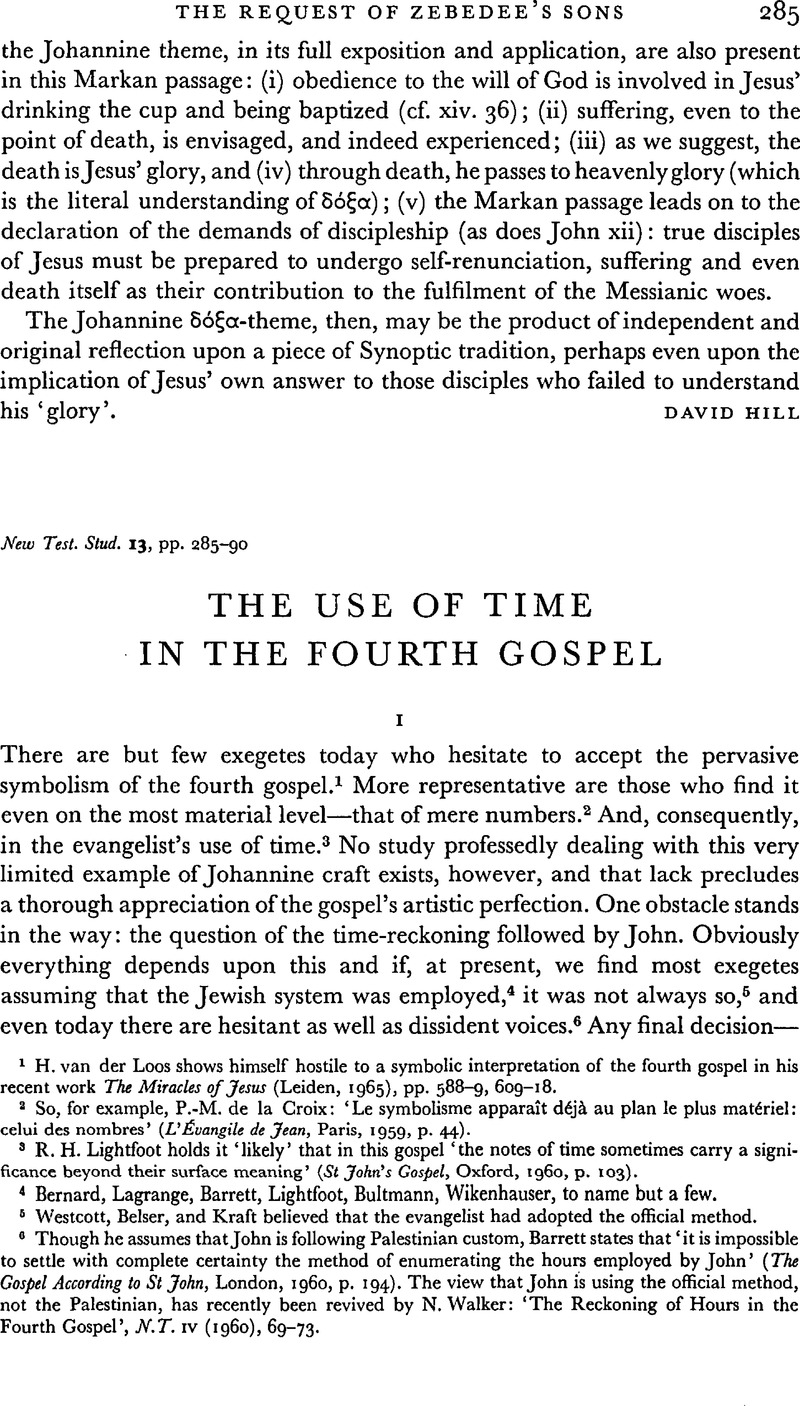No CrossRef data available.
Article contents
The Use of Time in the Fourth Gospel
Published online by Cambridge University Press: 05 February 2009
Abstract

- Type
- Short Studies
- Information
- Copyright
- Copyright © Cambridge University Press 1967
References
page 285 note 1 H. van der Loos shows himself hostile to a symbolic interpretation of the fourth gospel in his recent work The Miracles of Jesus (Leiden, 1965), pp. 588–9, 609–18.Google ScholarPubMed
page 285 note 2 So, for example, de la Croix, P.-M.: ‘Le symbolisme apparaît déjá au plan le plus matériel: celui des nombres’ (L'Évangile de Jean, Paris, 1959, p. 44).Google Scholar
page 285 note 3 Lightfoot, R. H. holds it ‘likely’ that in this gospel ‘the notes of time sometimes carry a significance beyond their surface meaning’ (St John's Gospel, Oxford, 1960, p. 103).Google Scholar
page 285 note 4 Bernard, Lagrange, Barrett, Lightfoot, Bultmann, Wikenhauser, to name but a few.
page 285 note 5 Westcott, Belser, and Kraft believed that the evangelist had adopted the official method.
page 285 note 6 Though he assumes that John is following Palestinian custom, Barrett states that ‘it is impossible to settle with complete certainty the method of enumerating the hours employed by John’ ( The Gospel According to St John, London, 1960, p. 194).Google Scholar The view that John is using the official method, not the Palestinian, has recently been revived by Walker, N.: ‘The Reckoning of Hours in the Fourth Gospel’, N.T. IV (1960), 69–73.Google Scholar
page 286 note 1 Historia Naturalis, II, 79, 188.Google Scholar
page 286 note 2 Op. cit. p. 151.
page 286 note 3 Op. cit. p. 103.
page 286 note 3 Op. cit. p. 103.
page 286 note 4 Bultmann merely affirms that the tenth hour signifies ‘den Beginn des Wirkens Jesu bzw. der “Christlichen Ära”’, but he does not indicate why that hour should have been chosen ( DasEvangelium des Johannes, Göttingen, 1962, p. 70).Google ScholarPubMed
page 286 note 5 Boismard, M.-E., (Paris, 1956), pp. 73–4.Google Scholar
page 286 note 6 Op. cit. pp. 69 f.
page 287 note 1 Guichou, P., Évangile de S. jean (Paris, 1962), p. 70.Google Scholar
page 287 note 2 Lightfoot, , op. cit. p. 116.Google Scholar
page 288 note 1 Cf. Abbott, E. A., Johannine Grammar (London, 1906), §§ 2608–27.Google Scholar
page 288 note 2 Cf. Bernard, J. H., St John, I (ICC) (Edinburgh, 1928), p. 170.Google Scholar
page 288 note 3 Op. Cit. p. 274.
page 289 note 1 Barrett, , op. cit. p. 374Google Scholar; Lightfoot, , op. cit. p. 275Google Scholar; Guichou, , op. cit. p. 211Google Scholar; Lagrange, M.-J., Évangile selon Saint Jean (Paris, 1948), p. 365Google Scholar; Hoskyns, E. C., The Fourth Gospel (London, 1947), p. 443Google Scholar; Grant, F. C., The Gospel of John, II (New York, 1956), p. 9.Google Scholar
page 289 note 2 Op. cit. p. 368.
page 289 note 3 Op. cit. p. 454.
page 289 note 4 Op. cit. p. 487.
page 290 note 1 The description of the contents given by Goodman, A. E., ‘The Jenks Collection of Syriac Manuscripts in the University Library, Cambridge’, J.R.A.S. (Oct. 1939), pp. 596–8Google Scholar, will be corrected in some points.


